A bright greenhouse hybrid with a fruity flavor adored by children and adults - the yellow date tomato
Tomato Date yellow is used not only for cooking various dishes, but also for decorative decoration of the garden area. The Russian hybrid has not only a pronounced tomato-fruit taste, but also a presentable look.
In the article, we will consider its distinctive features, stages of cultivation, and also find out what summer residents say about it.
The content of the article
Characteristics and description of tomatoes Date
Hybrid f1 Yellow date - the development of Russian breeders. It can be grown in all regions except the northern ones. In the south, the culture is bred in open ground, and in the middle lane - only in a greenhouse.
Distinctive features
The type is semi-determinant, the height is from 90 to 150 cm. The plant is able to adapt to short-term small frosts, but in this case the yield is significantly reduced. Therefore, it is planted in the ground only at the beginning of June.
The species is medium late, from the moment of sowing the seeds to full maturation, 120-130 days pass.The culture needs a mandatory garter, since there are so many fruits that the leaves are almost invisible. Plants are formed into 2 or 3 stems, pinned to the first brush.
The variety is highly resistant to many diseases of the nightshade family.
Fruit characteristics
The fruits are small, date-like, oval, slightly elongated. Average weight - 20 g, deep yellow color. The taste is sugary with a fruity undertone, the pulp is dense and juicy. The peel is strong, does not crack during storage and transportation.
Juicy pulp and dense skin allow ripe vegetables to be preserved without losing their appearance. They look great in glass jars, especially in assorted vegetables. Also, the fruits are used for drying and fresh consumption.
Because of their high glucose content, these tomatoes are loved by children. In addition to children, tomatoes are also used in dietary nutrition.
The photo shows tomatoes Yellow date.
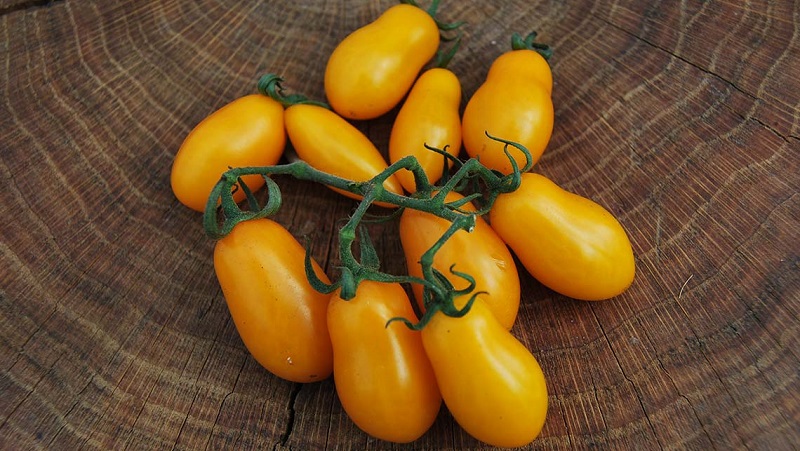
How to grow seedlings
Growing seedlings begins with sowing seeds in mid - late March, 2 months before planting in the ground.
Seed preparation
Seed preparation includes 3 stages:
- Rejection of seeds. Upon careful examination, non-viable specimens are disposed of.
- Check for emptiness. The seed is placed in a saline solution for 10 minutes. For sowing, only those grains that have sunk to the bottom are left.
- Disinfection of seeds.After disinfection, the grains become more resistant to infections and pests. For disinfection, dilute a weak solution of potassium permanganate and place seeds in it for 30 minutes. Then they are washed with running water and dried.
To increase germination, seed soaked for 10 hours in a growth stimulator - for this they use not only specialized drugs, but also folk methods, for example, aloe juice or honey water.
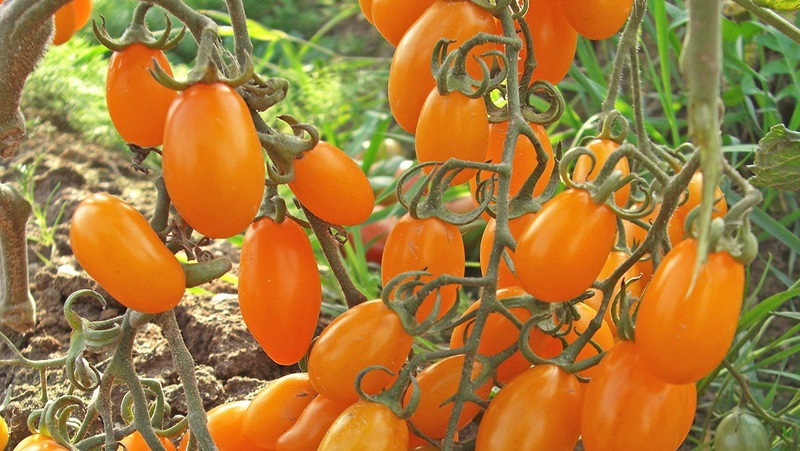
Capacity and soil
The soil is prepared from a mixture of garden soil, peat and river sand in equal proportions. Potash fertilizers are added to saturate the soil with useful substances. After thorough mixing, the resulting mixture is poured with a hot solution of dark potassium permanganate.
Thus, disinfection is carried out, destroying pathogens.The cooled soil is laid out in planting containers, filling them by two-thirds.
Reference.Potash fertilizers improve metabolism.
You can plant in a common wooden box or in an individual container. The main thing is not to forget to make small drainage holes at the bottom for the outflow of excess moisture, which causes rotting of the roots.
For the purpose of disinfection, prepared containers are treated with a manganese solution.
Sowing
The seeds are sown to a depth of 1 cm with a distance of 2 cm from each other, sprinkled with soil on top and slightly compacted. Moisten with a spray bottle with warm, settled water and cover with a film to create greenhouse conditions.
The seeded containers are left in a warm and bright room at a temperature of 24 ° C. Periodically, the film is removed for airing.
Seedling care
When shoots appear, the containers are rearranged on the windowsill. Daylight hours should be at least 13-14 hours. Therefore, you need to take care of additional lighting.
Reference. With a lack of light, the seedlings will begin to stretch and weaken.
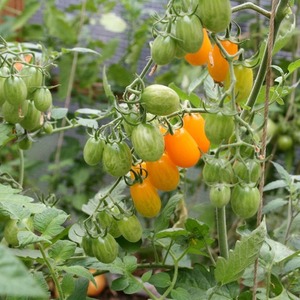 As the top layer dries up, the soil is moistened with warm, settled water using a shallow watering can. After watering, the soil is superficially loosened with a regular fork or wooden stick.
As the top layer dries up, the soil is moistened with warm, settled water using a shallow watering can. After watering, the soil is superficially loosened with a regular fork or wooden stick.
When two true leaves appear, the seedlings dive, seating them in containers with a diameter of at least 15 cm. After the dive, an enhanced build-up of lateral roots occurs and they will be cramped in small containers. When transplanting, only strong and healthy specimens are left for further development.
If growth is weak, then young bushes are fed with liquid fertilizer for tomato seedlings.
Two weeks before planting in the ground, the seedlings are hardened. This procedure helps them to settle down in the open field more quickly after transplanting. For hardening, the plants are taken outside in the daytime for 40 minutes. The time spent in the open air is gradually increased to 13 hours, while the night temperature is reduced to 13 ° C.
How to grow tomatoes
After 2 months of the seedling period, the root system is fully formed and is able to take root in the open field. At the end of the spring frost, the seedlings are ready for planting in the ground.
Landing
For two weeks, holes are prepared with a depth of 20 cm. A little peat is placed on the bottom and filled with water. Transplant seedlings on a cloudy day or in the evening hours after sunset. After transplanting, the holes are compacted and watered again with warm, settled water. When planting, young plants are buried to the cotyledon leaves.
Planting pattern: 40 cm - distance between seedlings, 65-70 cm - distance between rows. For 1 sq. m place 3-4 seedlings. Until the young bushes take root in a new place, they are not watered or fed.
Further care of the tomato Yellow date
Culture needs abundant watering during flowering and fruit formation. Before that, watered with moderately warm, settled water under the root of the plants, at least twice a week. If moisture gets on the leaves, a serious burn is possible, especially if watered during the day.
The culture responds well to drip irrigation. For this, a plastic bottle without a bottom is installed in the root system and filled with warm water. Thus, moisture gradually penetrates to the roots.
After watering, the soil is loosened and weeds and roots are removed. Weed grass takes a lot of nutrients from the soil, so its proximity to tomatoes is undesirable.
On dry days, the beds are mulched, thereby retaining moisture on them. Peat, straw or sawdust are used as mulch.
The hybrid is fed every two weeks, alternating the full range of mineral fertilizers with organic matter. During flowering, fertilized with phosphorus substances, and during fruiting, potassium salts are added for faster pouring of fruits. From organics, an infusion of mullein or bird droppings is used in a ratio of 1:15.
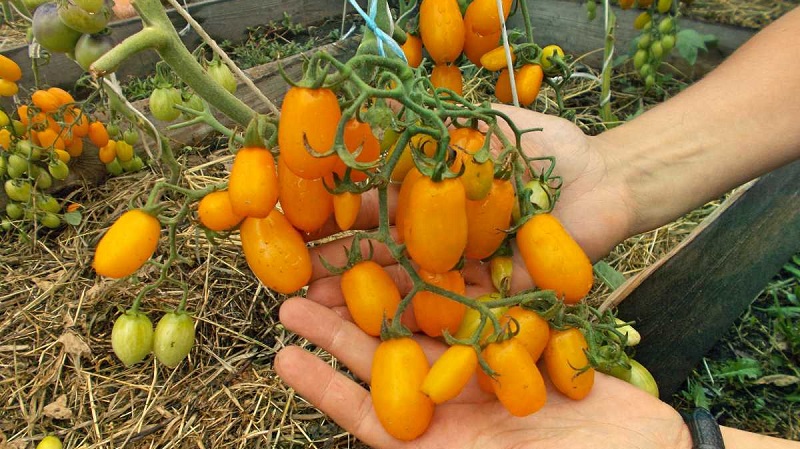
Features of cultivation and possible difficulties
A large number of forming ovaries require a mandatory garter. The most convenient way is to install the trellises and fix them to a horizontally stretched wire. Both the stem and the fruitful branches are tied, otherwise they will not support the weight of ripe vegetables. The garter on the trellis is also convenient in that the soft fabric bands with which the bushes are tied up do not injure the plant at all.
Stepson until the first flower cluster, leaving the rest of the shoots. Stealing is not considered a mandatory procedure, but if you leave the lower processes, then as they grow, thickening of the plantings is possible, which will prevent full development. In addition, with constant contact with wet beds, rotting of the lower leaves and the spread of fungal diseases are possible.
Diseases and pests
Observing the rules of crop rotation and performing simple agrotechnical procedures, gardeners thereby carry out prevention:
- disinfection of tomato beds with manganese solution - pathogenic flora is destroyed;
- spraying young bushes with onion husk infusion or nettle decoction;
- treatment with fungicidal preparations (with a real threat of disease).
Of insects, slugs and whiteflies are dangerous. To combat them, ammonia and strong manganese solutions are used. But do not abuse a strong concentrated manganese solution, as the leaves can get burned.
With a large accumulation of pests, insecticides are used. Otherwise, insects will harm many plants.
Nuances for open ground and protected structures
The date view can rightfully be considered a decorative decoration of the garden. The photo shows numerous branches decorated with small yellow date tomatoes. The hybrid grows up to 1.5 m in a greenhouse; in open beds, its growth does not exceed 1 m.
The height of the bushes does not affect the yield and taste of the fruit. Short frosts can reduce the quantitative indicator of fruiting. The hybrid will not die, but the fruit will be much less.
The tomato is successfully bred at home, on the balcony. It will perfectly take root in tubs and will become an unusual decoration for your home interior.
But the inhabitants of Siberia will only be able to grow a hybrid in heated greenhouses. The culture is not adapted to harsh conditions.
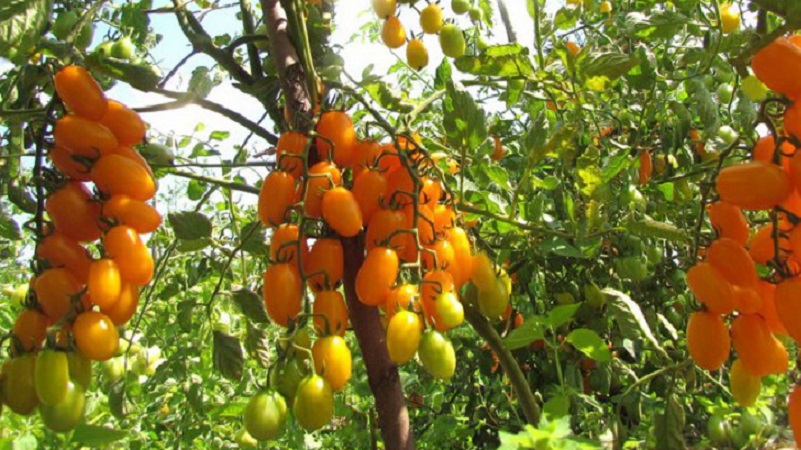
Harvesting and application of the crop
In early July, the first ripe tomatoes are harvested. When tied to a trellis, harvesting is easy. The main purpose of ripe vegetables is fresh consumption and drying.
Summer salads are especially distinguished from fresh dishes, where tomatoes perfectly complement the taste of other vegetables. The high sugar content makes them suitable for baby food. Also, yellow tomatoes are suitable for dietary nutrition, replacing red ones.
Not all tomatoes can be dried. Dried only small fruits with strong skin. But there is one more nuance: many tomatoes do not retain their taste when dried. But the yellow date tomato does not lose either beauty or taste.
Reference. Drying is a national Italian technology. Sun-dried tomatoes are an integral part of the diet of Mediterranean cuisine.
Ripe tomatoes can be stored for a long time and can withstand transportation over any distance.
Advantages and disadvantages
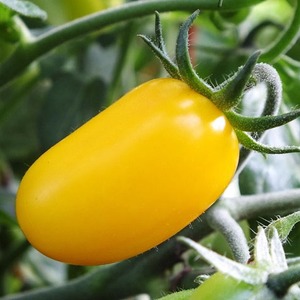 Let's start with the benefits of a hybrid:
Let's start with the benefits of a hybrid:
- uncomplicated agricultural technology;
- immunity to many tomato diseases;
- high rate of fruiting;
- great taste;
- unusual shape;
- suitable for dietary and baby food;
- high glucose content;
- safety of the presentation;
- good keeping quality.
The advantages include the possibility of breeding on the balcony at home. This is especially important for those who do not have summer cottages.
The hybrid has few negative sides. These include:
- obligatory garter;
- the impossibility of growing in the northern regions.
Tomato Date red
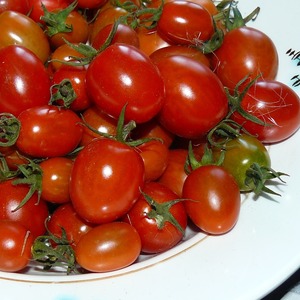 In addition to the yellow variety, Russian breeders have also bred a red date hybrid based on cherry tomatoes. It is similar to the yellow hybrid in both the growing characteristics and the appearance of the fruit. The red date belongs to the semi-determinant type with medium ripening periods.
In addition to the yellow variety, Russian breeders have also bred a red date hybrid based on cherry tomatoes. It is similar to the yellow hybrid in both the growing characteristics and the appearance of the fruit. The red date belongs to the semi-determinant type with medium ripening periods.
It takes root in greenhouse conditions in warm and temperate climates. Differs in resistance to dangerous diseases such as late blight and tobacco mosaic. Culture requires binding and pinching. To increase productivity, the plants are formed into 2 or 3 stems.
Ripe red date tomatoes are practically indistinguishable from yellow ones. Perhaps they are not as high in sugars, so they are less sweet.
They are used mainly for fresh salads and cocktails, they are stored for a long time without losing their presentation.
Farmers reviews
There are many reviews about the tomato and almost all of them are positive. Here are some of the opinions of experienced gardeners:
Svetlana, Nizhny Novgorod region: “The culture was bred in a polycarbonate greenhouse. I planted yellow and red hybrids, I wanted to make multi-colored conservation. Tomatoes were born wonderfully well. Everything is as on selection, sweet, with a strong skin that does not crack during heat treatment. Now I will be with tomatoes all winter. "
Natalia, Ivanovo: “The best tomato for children! In the morning they run to the garden and pick their favorite tomatoes. I have been growing dates for more than one year. For the first time I tried to dry the fruits. I was very pleased with the result. Real jam!".
Conclusion
By planting a yellow and red date tomato in your summer cottages, you will receive fruits of excellent taste, perfect for both baby and diet food. In addition, the advantage of this culture is that vegetables can be dried.
In addition to unusual fruits, the Russian hybrid is distinguished by high yield, immunity to many diseases and simple agricultural technology, which makes it possible to grow a unique tomato even for a beginner.